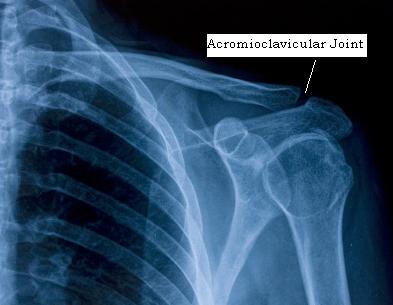Separated Shoulder (AC Joint Sprain)
Put your hand on your clavicle (or collar bone as many people call it) and follow it outwards as far as you can toward your shoulder; that big bump at the end on the top of your shoulder is called your acromioclavicular joint or “AC joint”. Traumatic injuries to this joint are common accounting for 9% of injuries to the shoulder. Sprain of the AC joint is often referred to as a separated shoulder.

Physiotherapy in Burlington for a Separated Shoulder
Separated Shoulder vs. Dislocated Shoulder
A dislocated shoulder is when the large bone in your arm actually comes out of the shoulder “socket”. An AC joint sprain or shoulder “separation” is when the lateral portion of your collar bone pulls away from the shoulder joint after trauma. Quite often these injuries involve a “step defect”, where the ligament damage has left the shoulder with a visible deformity since they can no longer hold the collar bone in place.
Who gets Separated Shoulders?
AC joint sprains are more common in younger adults, probably because they are more likely to be out taking chances and playing more aggressive sports. Statistically, these injuries are far more common in men than women. Usually the trauma would involve impact on the shoulder (like falling) with the arm either across the body or outstretched.
Types of Shoulder Separations
There are generally six types of AC joint sprains. The first being a mild sprain with no visible dislocation of the collar bone, all the way to the sixth type, which involves a rather significant dislocation of the joint. Types one and two can usually be managed conservatively with physiotherapy or chiropractic. Type three is border-line, but anything above (type four to six) warrants a consultation with an orthopedic surgeon.
Symptoms of Shoulder Separation
Usually there is pain locally in the joint (on the top pointy part of your shoulder) but you can also get some pain in the neck and throughout the shoulder joint. Newer injuries are usually painful with pressure and aggravated with bringing your arm up to shoulder level and across your body.
Treatment for AC Joint Sprains (Shoulder Separation)
As mentioned above, the milder types of AC joint injuries are the ones that we normally treat. Chiropractic and/or physiotherapy at our clinic can involve the use of various treatment modalities depending on the presentation of the patient. Some of these modalities include laser, interferential current (IFC), Graston, active release technique, acupuncture and rehabilitative exercise. Consulting with a chiropractor, in this case, is helpful so that diagnostic x-rays can be ordered and the degree of separation can be determined.
Unsure what to do? We can help you! Call or email us at info@burlingtonsportstherapy.com
References
Mazzocca AD, Arciero RA, Bicos J. Evaluation and treatment of acromioclavicular joint injuries. American Journal of Sports Medicine 2007; 35(2): 316-329.








